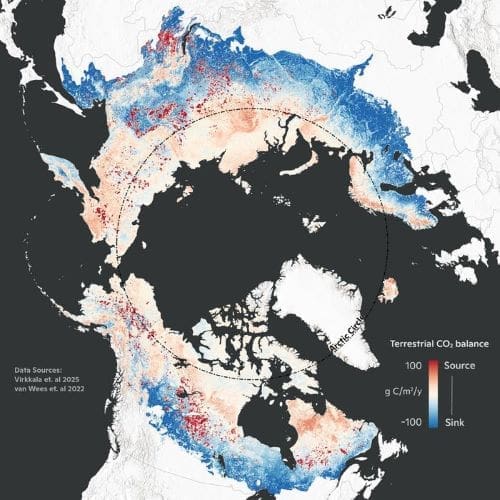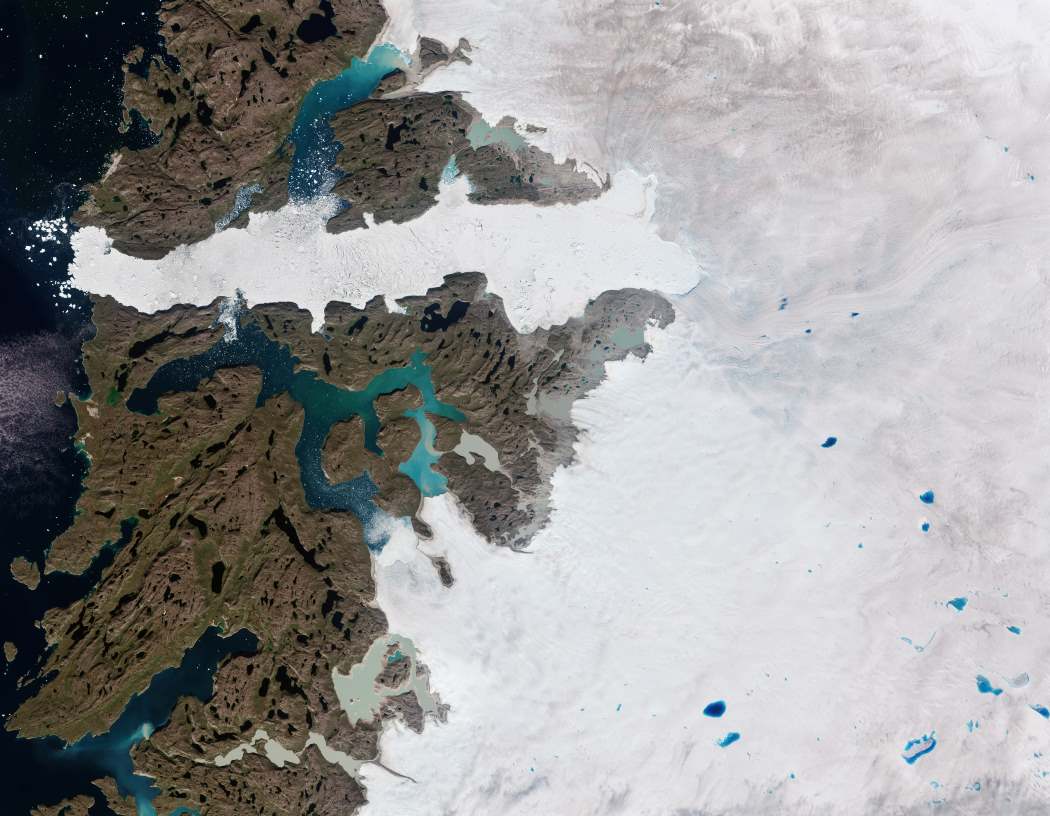After thousands of years functioning as one of Earth’s most crucial carbon sinks, the Arctic-boreal zone (ABZ) is undergoing a significant transformation.
Table of Contents
A new study published in Nature Climate Change reveals that more than a third of this expansive region now emits more carbon dioxide (CO2) than it absorbs — a stark reversal of its historical role in regulating the planet’s carbon balance.
Led by researchers at the Woodwell Climate Research Center, the study provides the most detailed assessment yet of carbon fluxes across the ABZ, which encompasses the treeless tundra, boreal forests, and wetlands of Earth’s northern latitudes.

The researchers found that 34 percent of the ABZ is now a net carbon source due to a combination of CO2 uptake by plants through photosynthesis and CO2 emissions from microbial and plant respiration. Factoring in emissions from wildfires — an increasingly frequent phenomenon in the north — the percentage of source areas jumps to 40 percent.
“We wanted to develop the most current and comprehensive picture of carbon in the north, and to do that, we knew we needed to account for fire’s growing carbon footprint in this region,” said Dr. Anna Virkkala, the study’s lead author and a research scientist with the Permafrost Pathways initiative at Woodwell Climate. “While we found many northern ecosystems are still acting as carbon dioxide sinks, source regions and fires are now canceling out much of that net uptake and reversing long-standing trends.”
A comprehensive record of carbon dynamics
The study’s findings are underpinned by a vast repository of data collected over three decades from 200 monitoring sites across the Arctic.
This dataset, known as ABC Flux, tracks CO2 exchange between land and atmosphere using carbon flux monitoring towers and chambers. By combining these site-level observations with climate, soil, and vegetation records, researchers created high-resolution maps (1 km x 1 km) to visualize changes in carbon processes across the ABZ from 1990 to 2020.
“The high resolution of these data means that we can now see how variable the Arctic is when it comes to carbon,” explained Dr. Sue Natali, a co-author of the study and lead of Permafrost Pathways. “That variability isn’t surprising because the Arctic isn’t one single place — it’s a massive area with diverse ecosystems and climatic conditions. And now we have the capability to track and map carbon processes at a spatial resolution that can reveal what’s happening on the ground.”
The analysis also sheds light on seasonal changes in the carbon cycle. While carbon uptake during summer has increased over the past 30 years, these gains are increasingly offset by heightened carbon emissions during the winter months, driven by longer growing seasons and more microbial activity in thawing permafrost.
“Carbon cycling in the permafrost region is really starting to change,” Virkkala noted. “Our study may act as a warning sign of bigger changes ahead, and offers a map of places we’ll need to better monitor in the coming decades.”
Wildfires and the carbon balance
One of the study’s most alarming findings is the growing impact of wildfires on the ABZ’s carbon balance. Fires release significant amounts of CO2, amplifying the region’s shift from sink to source. These disturbances have increasingly undermined the benefits of “greening,” where longer growing seasons and more vegetation allow for greater carbon sequestration.
Although 49 percent of the ABZ showed signs of greening, only 12 percent of those areas demonstrated a net annual increase in CO2 uptake. A warmer, greener Arctic doesn’t necessarily mean more carbon storage. Instead, warmer conditions often result in emissions from permafrost thaw and more carbon available to combust in wildfires.
The findings build on recent studies showing similar trends, including the role of lakes, rivers, and wetlands in releasing not only CO2 but also methane (CH₄), a potent greenhouse gas. Collectively, these results highlight the region’s declining ability to act as a carbon reservoir, with implications for global climate stability.
“We are seeing that longer growing seasons and more microbial activity in winter are gradually shifting carbon trajectories,” said Dr. Marguerite Mauritz, a co-author and assistant professor at the University of Texas-El Paso. “Highly collaborative efforts like this are critical for understanding how shifting seasonal dynamics and disturbance patterns can have regional and even global impacts.”
As the Arctic continues to warm, the researchers stress the importance of high-resolution monitoring to track these rapid changes.
With the ABZ at a critical tipping point, the study serves as both a warning and a roadmap for future research aimed at mitigating the climate crisis.
Journal Reference:
Virkkala, AM., Rogers, B.M., Watts, J.D. et al. ‘Wildfires offset the increasing but spatially heterogeneous Arctic–boreal CO2 uptake’, Nature Climate Change (2025). DOI: 10.1038/s41558-024-02234-5
Article Source:
Press Release/Material by Woodwell Climate Research Center
Featured image: Jakobshavn Glacier, Greenland. Credit: ©ESA




